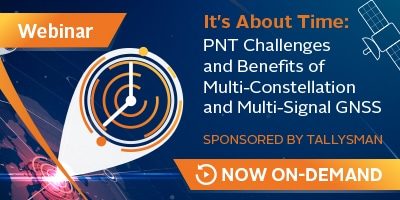PNT Challenges and Benefits of Multi-Constellation and Multi-Signal GNSS
In recent years, the number of GNSS constellations has grown from when GPS was the only constellation and most applications were single-frequency. Today, there are four GNSS constellations, with each constellation supporting three or more signals. While the GNSS systems grew, the radio frequency environment also expanded and became more congested with LTE and the anticipated Ligado (North America) signals. Both signal types are close to the GNSS band, and LTE signals have harmonics that fall within the GNSS band. This webinar will enumerate the benefits of multi-constellation and multi-signal PNT using the GNSS timing application space as a case study. It will conclude with a discussion of the challenges of operating in a congested radio frequency space.
Speakers:
 Julien Hautcoeur, Director of GNSS Product R&D, Tallysman Wireless Inc.
Julien Hautcoeur, Director of GNSS Product R&D, Tallysman Wireless Inc.
Julien Hautcoeur received a Ph.D. in signal processing and telecommunications from the Institute of Electronics and Telecommunications of Université de Rennes 1, Rennes, France, in 2011. After a four year postdoctoral training, he joined Tallysman Wireless Inc. in Ottawa, Canada, as an antenna and RF engineer and is now the Director of GNSS Product R&D.
 John Fischer, VP Advanced R&D, Orolia
John Fischer, VP Advanced R&D, Orolia
John graduated with a Masters and Bachelors of Science in Electrical Engineering and Computing Engineering from the State University of New York at Buffalo. For almost 20 years, John has been working with Global Navigation Satellite Systems (GNSS), wireless, positioning navigation and timing (PNT) and specialized systems for our customers at Orolia.
Prior to joining Orolia, he specialized in wireless telecom as a founding member of two startups: Aria Wireless in 1990 and Clearwire Technologies in 1997. He also worked as a systems engineer in radar, EW and command and control systems.
 Sunil Bisnath, Professor of Geomatics Engineering, York University
Sunil Bisnath, Professor of Geomatics Engineering, York University
Sunil Bisnath is a Full Professor in the Department of Earth and Space Science and Engineering at York University in Toronto, Canada. For over 25 years, he has been actively researching precise GNSS-focused positioning and navigation solutions and applications. He holds an Honors B.Sc. and M.Sc. in Surveying Science from the University of Toronto and a Ph.D. in Geodesy and Geomatics Engineering from the University of New Brunswick.

